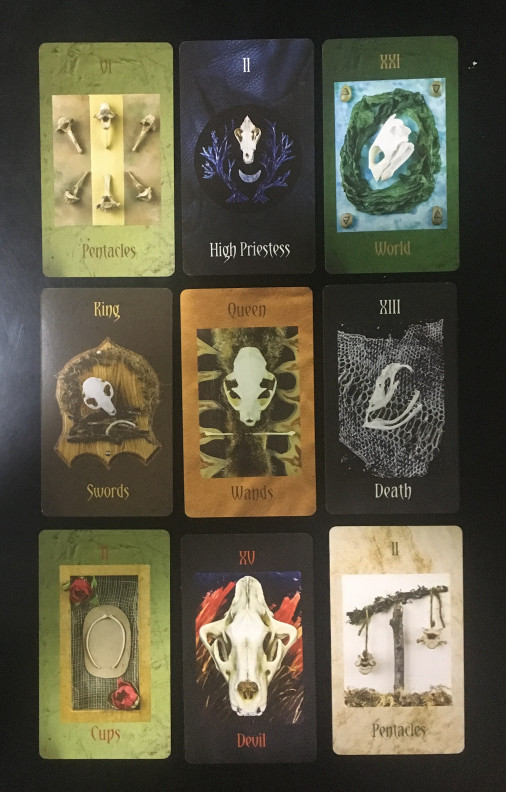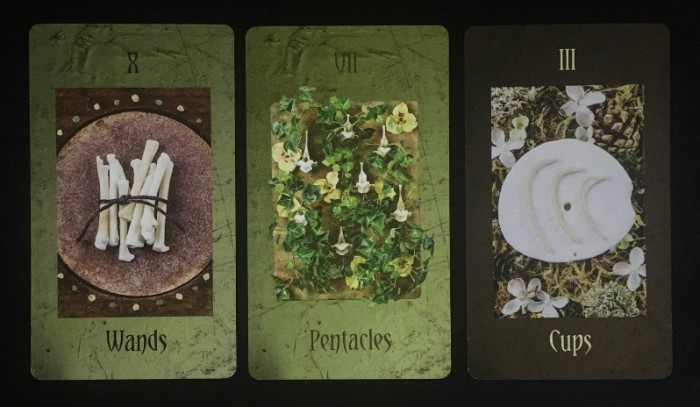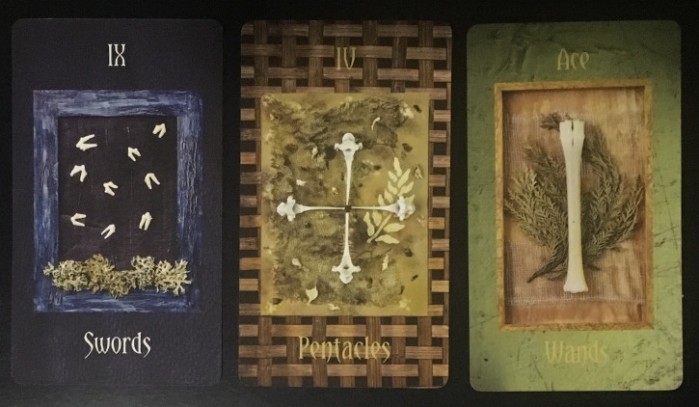Once, on a beach, I found a bird skeleton. This was the first time I found some animal bones. For a moment, it felt like being in an adventure movie, suddenly finding some lost treasure. Excited, I picked up the whole thing and happily brought it home with me, regularly checking on the bones to make sure that it was real. My adventure, however, ended badly, as I soon developed an acute rash in the skin and had to be brought to the hospital for a cortisone shot. The lesson was simple: treasures might be cursed and bones found in the wild are to be left alone, lest they bring some pestilence with them.
I never thought of going back to bones. In fact, I quite forgot the whole thing until today, when it came back to mind as I was writing this text about the newest tarot deck to grace my doorstep. A deck with one of the most interesting concepts I’ve seen in quite some time. A Tarot of Bones. As a recent Marseille convert, the idea of “reading to the bones” has become increasingly familiar, and in some cases, a mantra. How then would a set of cards which depicted only bones do, when one wanted a tarot reading?
Enter Lupa, a Neo-Pagan author who has been working with animal parts for some years now and published some work on the subject. For this deck, she has amassed an incredible amount of animal parts (both real and replicas) and assembled them into artistic installations that incorporated tarot symbolism. For the deck, skulls, rib bones, vertebrae, teeth and jaws and long bones from the legs and feet have been amassed, each particular sort of bone attributed to either the Major Arcana cards or one of the suits of the Minor Arcana. Hence, we find Skulls in the trumps, while rib bones were used for the suit of cups, long bones for wands, vertebrae for disks and teeth for swords. For the court cards, skulls and the bone that was attributed to a particular suit are present, so for example, the Knight of wands shows us the skull and the wing bone of an American Turkey.

Browsing through the deck, each card is both unique – with a particular background that agrees with the image depicted – and easy to identify, the name of the card plainly visible in the cards. The pictures are pleasing to the eye and invite us to return to a more natural world or, at least, a more nature-friendly world. This is, I think, one of the strengths of this deck. To let go of usual images that populate our human mind, with all the symbols and images that we use to stand apart from Nature and open the door to the natural world which lies all around us and let it in. I’ve been taking this deck with me for walks in beaches and parks and lying random cards on the ground to look at and meditate. They connect well with the natural world and, in fact, they seem stronger with this little exercise, speaking with a louder and clearer voice.
As for reading, well… skulls and bones don’t make for an easy reading if you, like me, can’t tell a hyena skull from a wolf skull. When I first opened the deck, and started looking at the cards my first thought was “how in hell am I going to read this?”. My problem was that I never got used to rely on keywords and when you’re used to work with images, it helps to actually be able to tell what you’re looking at. This is where Lupa’s companion book comes in handy (since there is no LWB accompanying the deck), by giving us both a description of the card and a peek behind the making of each assemblage as well as the reasons for a certain animal being selected. The book also tells us how the Waite-Smith system was used as the inspiration of the deck so expect to find some Waite-Smith inspired imagery.
But there is another way to read with it, and one that I found to be more fulfilling, which is to forget about everything you know about the tarot or, indeed, about the animals represented here and just let the images soak you. To let them come forth and freely enter your mind to tell you their story. My first question to the deck was “How can I work with you?” After laying three cards on the table, I got:

10 OF WANDS / 7 OF PENTACLES / 3 OF CUPS
“What is tied needs to be let loose. Spread us around your space and watch the ripples as they unfold.” Oh! This was easy, I thought. To forget about meanings and traditional depictions and reading systems. To forget about bones and animals and everything related to them and just let it flow. But then, what was I to expect from a deck that prompt us to reconnect with the rhythms of nature? To just let go of everything and go with the flow. If you want a reading to the bones, strip out all the meat and fat to focus on focus on what’s necessary.
All good and dandy then. Time to go to the next question, I thought. “What do you have to tell me?”

9 OF SWORDS / 4 OF PENTACLES / ACE OF WANDS.
This one took me a bit longer than the previous one. Which, to be quite honest, I liked, as it tells me that there’s things to explore in here. Mysteries to be discovered. So I went with the theme: 9 sets of bone shards are spread all around the tableaux. They might be teeth but spread out this way they will hardly cut anything. What good then, does to be sharp, if you can’t exercise that sharpness? In the next card, the four of pentacles, four vertebrae are joined together in a cross. It almost seems as if all those shards came together to form these larger structures. Where previously there was chaos and entropy, now there’s stability; there’s a sense of order. And then, as we look at the ace of wands, we can easily see how each branch of the bone cross rose and melded to form the long bone visible in the last card. My snappy sentence would then be “What is separated needs to be put together. Do this in steps, looking first for stability and then for unity.”
The progression from Swords to Pentacles to Batons tells me that there are advantages to this approach. Swords turn into coins, loosing their sharp edges and bringing in rewards which can then be used to build a wand. Batons being associated with work and might, this tells me that by bringing focus to my work, things will be able to grow faster and stronger (notice how the size and the volume of the bones increase from card to card).
Looking up to the first reading I can see how they complement each other. One telling me to let go and become looser, the other, to concentrate and focus. If anything, I’m again recalled of the rhythms of nature. Of things expanding and contracting and how important it is to stay in the flow of things. Nature has seasons, after all, and these seasons teach us that there is a time for everything. It’s back to the basics then, remaining open and aware of what lies in front of us.
The Tarot of Bones can be ordered from the author here. Be sure to pass by her site and check all the cards of the deck as well as the sculptures that were made for each card. There’s great work there. For more about Lupa and her work, just visit her site.


Excellent review!
That’s a very intersting deck.
At first I thought you were going to tell us you had taken up “Throwing the Bones”. Something I want to try.
I loved the way you did “read the bones” and bought the two together.
It is! I like the deck. I like it that it is about bones, which is something we can relate to and at the same time that deviates from the traditional images. It is such a no-brainer that I’m surprised no one ever came forth with this.
The readings were actually very fluid. Very easy to do. When you rely on images, which is what I basically do, and bring in keywords to complement / inform what you’re seeing there’s really no deck that you can’t take on. The images point the way forward. Always. So one just needs to sit back and let the mind do its stuff. The rest is just… fireworks.
I recently brought home the jaw bones (with teeth) intact of a fawn. The whole set was there but I passed on claiming any other parts of the fawn. Glad I didn’t end up in the hospital! I’m curious to know what cards my jaw bones might correlate to. What do your cards say?
-gayle
As I was explained in the hospital at the time, the sash came because I picked up and played with the skeleton of a dead animal, which was thriving with dangerous bacteria (a clean skeleton wasn’t cleaned after all). I should have used gloves when dealing with it, but how was I supposed to know that as a child? People in the movies would do that all the time…
Jaw bones would be swords. The six of Swords, in fact, has the partial skull (with teeth) of a whitetail doe.
I can’t seem to be able to add a picture of the card from my cellphone, so here’s the link to the card, as depicted on the deck’s site:
http://www.thetarotofbones.com/otw-portfolio/six-of-swords/
nice review……i been fan of her work ,am from scotland so not met her face to face but i do like the primal format of her work and when i found out about this i backed first time round and , bones are rare subject theres not many book that deal with bone throwing or even form tarot with balance of nature and bones as in end we all just bones our self
This was my first exposure to Lupa’s work. And what an exposure! This is a very special tarot, because it does not speajs loudly. Rather it whispers and kindly asks you to stop and listen. Just listen. The bones are trying to tell you something. If you would only just listen.